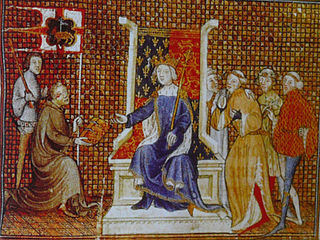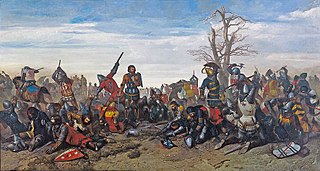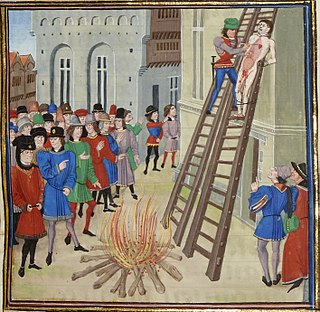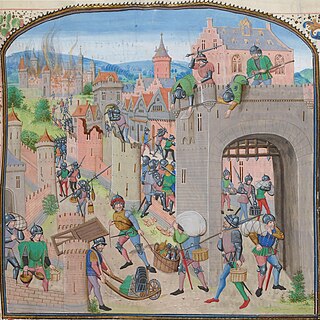
Philippe de Mézières, a French soldier and author, was born at the chateau of Mézières in Picardy.

Joanna of Bourbon was Queen of France by marriage to King Charles V. She acted as his political adviser and was appointed potential regent in case of a minor regency.

The Combat of the Thirty, occurring on 26 March 1351, was an episode in the Breton War of Succession fought to determine who would rule the Duchy of Brittany. It was an arranged fight between selected combatants from both sides of the conflict, fought at a site midway between the Breton castles of Josselin and Ploërmel among 30 champions, knights, and squires on each side. The challenge was issued by Jean de Beaumanoir, a captain of Charles of Blois supported by King Philip VI of France, to Robert Bemborough, a captain of Jean de Montfort supported by Edward III of England.

Charles of Blois-Châtillon, nicknamed "the Saint", was the legalist Duke of Brittany from 1341 until his death, via his marriage to Joan, Duchess of Brittany and Countess of Penthièvre, holding the title against the claims of John of Montfort. The cause of his possible canonization was the subject of a good deal of political maneuvering on the part of his cousin, Charles V of France, who endorsed it, and his rival, Montfort, who opposed it. The cause fell dormant after Pope Gregory XI left Avignon in 1376, but was revived in 1894. Charles of Blois was beatified in 1904.

Froissart's Chronicles are a prose history of the Hundred Years' War written in the 14th century by Jean Froissart. The Chronicles open with the events leading up to the deposition of Edward II in 1327, and cover the period up to 1400, recounting events in western Europe, mainly in England, France, Scotland, the Low Countries and the Iberian Peninsula, although at times also mentioning other countries and regions such as Italy, Germany, Ireland, the Balkans, Cyprus, Turkey and North Africa.

Geoffroi de Charny was the third son of Jean de Charny, the lord of Charny, and Marguerite de Joinville, daughter of Jean de Joinville, the biographer and close friend of France’s King Louis IX. A renowned knight who fought on the French side during the early years of the Hundred Years’ War, Charny wrote a semi-autobiographical poem, The Book of Geoffroi de Charny, and a set of questions on chivalric matters for the short-lived Company of the Star, France’s counterpart to England’s Order of the Garter. Although a prose treatise called the Book of Chivalry has also long been accredited to him, recent findings indicate this to have been more likely by his son of the same name, Geoffroi II de Charny, who died in 1398. Charny is also widely associated with the first known showings of the Shroud of Turin, though there are now doubts that he was responsible for these.

Hélie de Talleyrand-Périgord was a French Cardinal, from one of the most aristocratic families in Périgord, south-west France. Hélie was born at Périgueux, third son of Elias VII, Count of Périgord, and Brunissende of Foix, daughter of Roger Bernard III, comte de Foix. His elder brothers were Archambaud (IV), who inherited the County, and Roger-Bernard ; his younger brother was Fortanier, and his sisters were Agnes, Jeanne, Marguerite, and Rosemburge. As a third son Hélie was destined for an ecclesiastical career. His brother, Roger Bernard, too, had an ecclesiastical career, becoming Canon of Lyon. But then, the eldest son died, and Roger-Bernard became the Count of Périgord. Hélie became a major figure in the Avignon papacy, and also a diplomat engaged in the negotiations of the Hundred Years' War, having friendships in both English and French royal families. In his last months he had been appointed Papal Legate for a crusade against the Turks.
Philippe Mouskes was the author of a rhymed chronicle that draws on the history of the Franks and France, from the origins until 1242.
Tard-Venus were medieval groups of routiers that ravaged Europe in the later years of the reign of King John II of France.

Francois Hennequin, was a mercenary captain during the Hundred Years War.

Naudon de Bageran, was a mercenary captain during the Hundred Years War.

Robert Birkhead (Briquet) was a mercenary captain during the Hundred Years War.

John Creswey was an English mercenary captain during the Hundred Years War.

Aymon of Ortinge, also known as Amanieu d'Ortigue or Amanieu de l'Artigue, was a French mercenary captain during the Hundred Years' War. His story is mentioned in the Chronicles of Froissart.

Bernard de la Salle, was a French mercenary captain during the Hundred Years War. His story is mentioned in the Chronicles of Froissart
Bernard de Wisk was a mercenary captain and sometime brigand of the Hundred Years War.

Bour de Breteuil was a Mercenary captain of the Hundred Years War.

Bour Camus, or Camus Bour Lesparre, also known as Camus the Bastard was a mercenary captain during the Hundred Years War. He was of Navarrese or Gascon origin.









